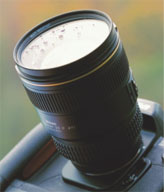Circular Polarizers - Increase Color Saturation, Reduce Reflections

The images on the left was taken without any filter.
The image on the right was taken using a
B+W Circular Polarizer. Click for larger view. 
The images on the left was taken without any filter.
The image on the right was taken using a
B+W Circular Polarizer. Click for larger view. Highly efficient standard circular polarizing filter for all cameras with beam splitters in the light paths of their TTL exposure meter and with autofocus lenses. Circular polarization has the same pictorial effect as linear polarization, but allows for proper exposure metering and/or autofocus distance settings.
B+W Polarizers increase color saturation and reduce reflections. The neutral gray color and plane parallel polarizer material guarantee optimal image results. High-quality optical glass ensures excellent pictorial quality. The filter factor varies according to how the filter is positioned in relation to the sun. Exposure compensation is about two f-stops.
Linear and circular polarizers both consist of a linear polarizer foil but differ in their construction in the following way. Modern DSLR cameras have a beam-splitting prism that sends part of the incoming light to the meter and part to the viewfinder. The effect is that the light entering the meter is partially polarized by the beam-splitter. A linear polarizer placed on the lens of such a system will act as a second polarizer and block light to the meter by a degree dependent on the angle between the prism and the polarizer on the lens. The result is incorrect exposure/aperture values from the meter. The circular polarizer circumvents this problem through the addition of a 1/4-wave retarder, or delay foil. This ensures that the linearly polarized light is changed into a rotation that appears unpolarized to the meter, resulting in proper exposure/aperture readings.
MRC - A Special Scratch-Resistant, Water and Dirt Repelling Coating

The left half of this filter has a
traditional coating. The right half
has MRC coating.
The lens elements of high-quality lenses and the plano surfaces of filters require a perfect shape and smoothness to achieve the best optical quality. Dirt, greasy fingerprints, water marks and scratches reduce the image contrast and the sharpness, which can result in blooming at light sources and have an effect similar to a soft-focus lens. A clean front lens element and clean filter surfaces are therefore an absolute pre-requisite for demanding photographers.

MRC coating causes water
to bead up and slide right off.
The MRC coating is first and foremost a broadband anti-reflection coating. This means that its reflection-reducing effect, which is thus also a transmission-increasing effect, i.e. one which suppresses scattered light and ghost images and transmits more light, has a broadband action over the full spectrum. In contrast, the (almost always blue) single-layer coating only has a high effect in the medium wavelength range around yellow and yellow-green where the eye is most sensitive to light, while its effect is greatly reduced toward the blue-violet and purple-red end regions of the visible spectrum. With the MRC coating, this blue, violet and red to deep-red light cannot produce any contrast reducing scattered light, spotty reflections or ghost images. A broadband effect can only be achieved with a multilayer coating which requires a much higher effort and precision because unevenness and irregularities of the individual layers build up on one another and amplify one another. Schneider therefore uses a plasma-assisted evaporation coating process in which inert gas ions accelerated in an electrical field compact the material deposited on the lens surface in the vacuum chamber.
For photographers, the main advantage of MRC coating, is it's ability to combat flare and ghosting. An added benefit is that their filters remain free of dirt longer, so that they do not have to be cleaned so often. When cleaning the filter does become necessary, it is a lot easier to wipe off the dirt with a blower brush, because of MRC's ability to repel dirt and moisture. This also reduces the risk of micro-scratches which can occur during cleaning.
Slim Line Filter Mount
This filter uses a rotating Slim-Line mount made of aluminum for wide angle lenses. They do not have a front accessory thread to avoid vignetting with lenses as wide as 17mm in 35mm format. Some report success with lenses as wide as 16mm. A slip on cap is supplied.
Because this is a rotatable polarizing filter, it has a height of 5mm.